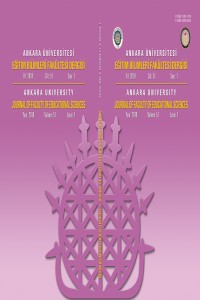Abstract
Bu çalışmanın amacı çevrilmiş öğrenme modeliyle yapılan müzik derslerine
ilişkin görüş ve algıları tespit etmek üzere bir ölçek geliştirmektir. Bu
amaçla oluşturulan deneysel form uzmanlara sunulmuş ve dönütler doğrultusunda
maddelerin kapsam geçerlik oranı belirlenmiş ve .40’ın altında değer alan
maddeler çalışma kapsamı dışında bırakılmıştır. Oluşturulan 23 maddelik deneme
formu 141 öğrenci üzerinde uygulanmış, elde edilen veriler analiz edilmiş ve 12
maddelik bir yapıya ulaşılmıştır. Açımlayıcı Faktör Analizi (AFA) ile “Bilgi”,
“Farkındalık” ve “Beceri” olmak üzere üç boyutlu ve toplam 12 maddeden oluşan
bu yapının alt ölçekleri arasındaki ilişkiye bakılmış ve faktörlerin
birbirleriyle pozitif ve anlamlı ilişki içinde oldukları görülmüştür. Alt
boyutların müzikte çevrilmiş öğrenme modeli algısını ortaya koyan bileşenler
olduğu ve birlikte bir üst yapıyı oluşturduğu görülmüştür. Ölçeğin tümü için
elde edilen iç tutarlılık katsayısı ise .80 olarak belirlenmiştir. Müzik
dersinde çevrilmiş öğrenmeye ilişkin geçerli ve güvenilir bir ölçek
geliştirilmiştir.
References
- Anderson, L. W., and Krathwohl, D. R. (Eds.). (2001). A taxonomy for learning, teaching and assessing: A revision of Bloom's taxonomy of educational objectives: Complete edition, New York: Longman.
- Bergmann, J., and Sams, A. (2012). Flip your classroom: Reach every student in every class every day. International Society for Technology in Education. Washington: Iste.
- Bergmann, J., and Sams, A. (2014). Flipped learning: Maximizing face time. T+DJournal, 68(2), 28-31.
- Bloom, B. S. (ed.)(1956). Taxonomy of Educational Objectives. Vol. 1: Cognitive Domain. New York: McKay.
- Büyüköztürk, Ş. (2002). Faktör Analizi: Temel Kavramlar ve Ölçek Geliştirmede Kullanımı. Kuram ve Uygulamada Eğitim Yönetimi, 32, 470–482.
- Comrey, A. L., and Lee, H. B. (1992). A first course in factor analysis (2nded.). Hillsdale, NJ: Erlbaum.
- deVries, P. (2004). The Extramusical Effects of Music Lessons o Preschoolers, Australian Journal of Early Childhood, 29(2), 6–10.
- Grant, C. (2013). First inversion: A rationale for implementing the “flipped approach” in tertiary music courses. Australian Journal of Music Education, 1, 3–12.
- Herreid, C., and Schiller, N. (2013). Case Studies and the Flipped Classroom. Journal of College Science Teaching, 42, 62-66.
- Janz, K., Graetz, K., and Kjorlien, C. (2012). Building collaborative technology learning enviroments. SIGUCCS ’12 Conference, Memphis, Tennessee, USA.
- Kreutz, G., Schubert, E. and Mitchell, Laura A. (2008), Cognitive Styles of Music Listening, Music Perception: An Interdisciplinary Journal, 26(1), 57-73, University of California Press.
- Lamont, A. (1998). Music, Education and the development of pitch perception: the role of context, age, and musical experience. Psychology of Music, 26(1), 7-25.
- Lento, C. (2016). Promoting active learning in introductory financial accounting through the flipped classroom design. Journal of Applied Research in Higher Education 8(1), 72-87.
- Mantie, R., and Tucker, L. (2008). Closing the gap: Does music making have to stop upon graduation? International Journal of Community Music, 1, 217-227.
- McKnight P., McKnight, K., and Arfstrom, K. (2013). A review of flipped learning. Flipped Learning Network.
- Milman, N. (2012) The flipped classroom strategy: What is it and how can it be used? Distance Learning, 9(3), 85-87.
- Özdamar, K. (2002). Paket Programlar ile İstatistiksel Veri Analizi. 4. Basım, Eskişehir: Kaan Kitabevi.
- Pearson, G. (2012) Biology teacher’s Flipped Classroom: ‘A simple thing, but it’s so powerful’. Education Canada, 52(5).
- Pierce, R. and Fox, J. (2012). Vodcasts and Active-Learning Exercises in a “Flipped Classroom” Model of a Renal Pharmacotherapy Module. American Journal of Pharmaceutical Education: 76(10), 196.
- Raths, D. (2014). Nine video tips for a better flipped classroom. Education Digest, 79(6), 15-21.
- Sever, S. ve Sever. G. (2017). Students'self-Assessments Regarding The Effects of Flip Learning Practice In Music Lessons. Electronic Turkish Studies 12(18), 20.
- Standley, J.M. (1996). A meta-analysis onthe effects of music as reinforcement for education/therapy objectives. Journal of Research in Music Education, 44, 105-133.
- Tabachnick, B.G. and Fidell, L. S. (2001). Using multivariate statistics (4th Ed). Needham Heights: Allyn & Bacon.
- Tune, J. D. Sturek, M. Basile, D. P. (2013). Flipped classroom model improves graduate student performance in cardiovascular, respiratory, and renal physiology. Advances in Physiology Education: 37, 4.
- Turan, İ , Şimşek, Ü , Aslan, H . (2015). Eğitim Araştırmalarında Likert Ölçeği ve Likert-Tipi Soruların Kullanımı ve Analizi. Sakarya Üniversitesi Eğitim Fakültesi Dergisi, (30), 186-203.
- Yurdagül, H. (2005). Ölçek Geliştirme Çalışmalarında Kapsam Geçerlik İndeksinin Kullanımı. 14. Eğitim Bilimleri Kongresi, Pamukkale Üniversitesi, Denizli.
Details
| Primary Language | Turkish |
|---|---|
| Subjects | Studies on Education |
| Journal Section | Articles |
| Authors | |
| Publication Date | April 1, 2018 |
| Published in Issue | Year 2018 Volume: 51 Issue: 1 |
Ankara University Journal of Faculty of Educational Sciences is licensed under CC BY-NC-ND 4.0

